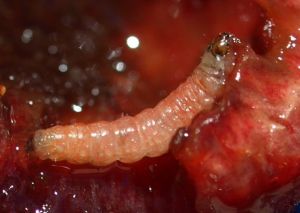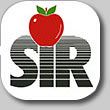Cherry Fruitworm
General Description
Hosts
Primary hosts are sweet and sour cherries and blueberry; wild hosts include bittercherry/wild cherry (Prunus emarginata), chokecherry (P. virginiana); other reported hosts include apple, hawthorn, plums, peaches, pears, Pyracantha (firethorn), roses, quince.
Damage
Larvae feed on the flesh around the pit of cherries (Fig.1), and cut an exit hole to further downgrade the fruit (Fig. 2); often distort fruit (‘monkey faced’). Feeding damage can be confused with that of cherry fruit flies, however the presence of brown pellets of frass near the pit indicate fruitworm feeding. Damage to other tree fruits has not been identified in the B.C. Interior.
| Figure 1. Larval feeding damage. (H. Philip) | Figure 2. Exit hole in cherry. (H. Philip) |
Identification
Larva - Young larvae (caterpillars) white with a distinct black head; mature larvae 7.5 – 9 mm long with pale pink body and pale brown head and thoracic shield (Fig. 3).
 |
| Figure 3. Cherry fruitworm larva. (H. Philip) |
Pupa - About 6 mm long, golden brown colour, in silken cocoon.
Adult - Small moth with 9 – 11 mm wing span and with dark gray and black stripes across the forewings.
Life History
Cherry fruitworm overwinter as larvae in small bark wounds of host trees, or more commonly in a 2.5 – 5 cm tunnel bored down the soft centre of pruning stubs. The entrance is plugged with silk. Pupation begins the following May and, depending on location, adults begin to emerge in early June, peaking in mid June, and present until mid July or later. Moths rest during the day in the tree and are active from late afternoon until dark. Single eggs are laid on the fruit, most commonly in the suture of the fruit near the tip. Eggs hatch in about 7 - 10 days and the young larvae bore into the fruit and tunnel to the pit where they develop over the next 3 weeks. Beginning late July, mature larvae leave the fruit through an exit hole and wander about the tree in search of overwintering sites. Many larvae do not exit the fruit before harvest, especially if the weather has been unseasonably cold. There is only one generation each year.
Monitoring
Place pheromone-baited traps (use false codling moth lures because the cherry fruit worm lure is not effective in BC) in orchards before moths emerge in the spring at a rate of one per hectare. At present no relationship between trap captures and potential fruit infestation is established. Because the larvae can be confused with cherry fruit fly larvae, it is important to protect the fruit from infestation beginning in early June and continuing until the fruit is harvested or until about 10 days after the last moth is captured.
Management
Cultural Control
Destroy infested cherries before the larvae emerge. Do not leave any unharvested unprotected fruit on the trees while adults are present. Destroy any nearby unmanaged cultivated and wild hosts.
Chemical Control
Cherry fruitworm is an occasional pest of cherry because control products applied against spring leafrollers in early June and broad-spectrum cherry fruit fly sprays in June and July also control cherry fruitworm. However the use of products that only control cherry fruit fly may increases the risk of cherry fruitworm infestations. If the pest is present, it is recommended that more broad-spectrum products be applied against cherry fruit fly during the period of adult cherry fruitworm activity.
